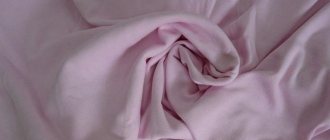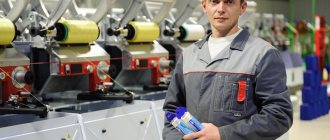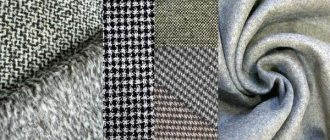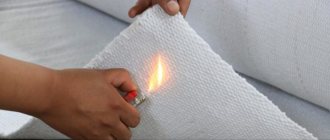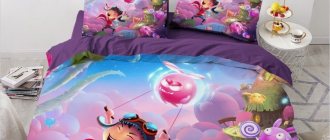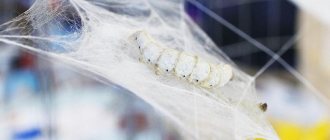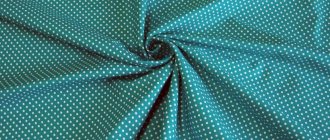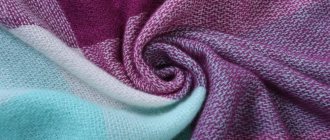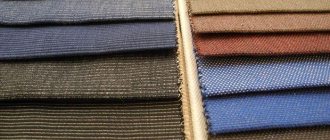What to sew from interlock?
Like other knitted fabrics, interlock is suitable for creating comfortable products with a loose silhouette. Due to its special tactility and softness, smooth surface texture on the reverse side and on the front side, this type of cotton knitwear is actively used in the production of children's products - on an industrial scale and for DIY sewing.
The entire range of products for newborns - swaddling bags and overalls, bodysuits and T-shirts, sandboxes, dresses, rompers and light jackets, hats and undershirts - can be easily sewn from interlock. It is soft and hygienic, which allows you to use this cotton from the first days of life. The abundance of calm and bright children's prints and colors gives everyone the opportunity to choose a material to their liking.
Children's clothing for older children? Yes, long sleeves and T-shirts, trousers and suits for kindergarten are sewn from this fabric. Interlock pajamas are a great gift for your loved ones.
Plain interlock is an excellent base for loungewear. Women's dressing gowns and home sets, men's T-shirts are incredibly soft, suitable even for those with sensitive skin. Having put on a relaxed interlock dress, you will not exchange it for anything else!
Our online store offers an impressive selection of interlock for every taste. Printed pattern or laconic colors - for a wonderful mood at home and wherever you need comfortable, thoughtful looks with knitwear. A detailed description and photo for each item will help you make your choice.
How is interlock different from cooler?
What do you think is the difference between different types of knitwear? Both of these fabrics are made primarily from 100% cotton and are used for sewing children's clothing. But there is one significant difference - the density of the knitwear. The kulirka, made by single weaving of fibers, turns out to be thin, elastic, similar to tricotine, suitable mainly for the summer assortment. Interlock is much denser and warmer, which means it is preferable to use it for other purposes - first of all, clothing and underwear for babies and children.
Compound
For quite a long time, only 100% cotton fabrics created by the method of very tightly weaving loops were considered interlock. In the production of the material, two rows of knitting machine needles are used, which ensures the same structure on both sides. If we talk about density, then for classic knitwear it ranges from 240 g/m2 to 330 g/m2. This is a fairly high indicator: the material has good thermal insulation properties, and in winter it is not cold in such underwear.
Scheme and graph of double elastic weave (interlock)
However, today no less popular are blended options, the composition of which does not involve 100% cotton, but the addition of synthetics, most often polyester or lycra. Such interlock fabrics are more elastic and durable, although they are somewhat inferior in terms of hygiene. In addition, they are much cheaper than natural varieties. The addition of synthetic fibers, among other things, allows you to create warm brushed fabrics.
Types of interlock - what kind is it?
You've probably noticed that fabrics with the same names do not always have the same properties; one of them will certainly be better than the other. This is due to the fact that manufacturers can use raw materials from different sources, the quality of which may vary.
The cotton fibers from which knitwear is made can be classified in accordance with international requirements for the quality of the finished fabric, the raw materials used in production and the external characteristics of the material. Natural cotton fibers, from which threads for future textiles are spun, can have an original length of 20 to 70 mm. The final quality of cotton mainly depends on it. There are three main types of cotton knitwear:
Peñe . This is the gold standard for quality among cotton fabrics. Knitwear with the best consumer properties is made from strong, uniform, tightly twisted fibers 30-70 mm long. Raw materials of the highest quality are freed from lint, fluff, and porous fibers by grinding. Additional processing eliminates residual defects so that future materials are not subject to peeling or excessive stretching.
Peñe compact is a knitwear product from the “pene” category with premium properties. It has a silky, smooth surface, retains heat well, does not wrinkle and retains its original appearance for as long as possible. The basis for it is the highest quality cotton.
Ring (also known as carde). Knitted fabrics in this category are made from fibers 25-35 mm long. They are more fluffy, a little loose, with less density, but at the same time they still have a rather smooth structure overall. Ring cotton is very common - its cost is low, and its characteristics delight sewers with its versatility.
Open End ( O/ E) - the lower gradation of the quality of cotton fabrics. Loose, short fibers 20-30 mm long become the basis of an inexpensive fabric, characterized by low strength and density. At the same time, O/E cotton has all the main advantages of cotton - hygroscopicity, breathability and hypoallergenicity. Sometimes cheap knitwear is subjected to additional treatment with enzymes, which helps prevent the surface from pilling.
If other fibers are added to the interlock cotton base, this does not degrade its quality, but only provides additional benefits. Thus, synthetic fibers with weak twist allow you to create a small pile on the surface. The addition of viscose improves tactile characteristics and slightly reduces the cost of the material.
Advantages and disadvantages of interlock
Durable and high-quality interlock has been valued by craftswomen for many years. He actually has an impressive list of advantages.
- Excellent appearance and tactility. The material with a smooth surface is pleasant to touch and wear. Interlock does not restrict movement and guarantees ease of use.
- The canvas (not fabric) has great tensile strength. It is almost impossible to damage it mechanically, which means that as a result of a hook or a cut, the loops do not unravel.
- The practicality of interlock allows you to sew items from it for every day - they do not lose their original external properties for a long time. It is also resistant to deformation. The material does not stretch during wear, and after slight deformation it immediately (at most after washing) returns to its shape. Even after numerous washes, there will be no pilling on the interlock and it will not lose its color brightness.
- The material is susceptible to intense coloring - prints of any shades and sizes adhere perfectly to its surface. At the same time, unlike ordinary knitwear, interlock does not fade or turn yellow from exposure to ultraviolet radiation.
- Interlock has an affordable price, which makes it both an excellent choice for sewing several items of clothing yourself at home, and the basis for the industrial sewing process.
- This type of knitwear is ideal for use even for beginners. It does not crumble, fits well, and the edges do not curl when cut.
The material has significantly fewer disadvantages, but they cannot be ignored
- The elasticity of such knitwear is low - products with soft draperies cannot be made from it, and a perfect fit to the figure cannot be achieved either.
- With improper care and excessively high washing temperatures, there is a high risk of shrinkage of cotton fabric, including interlock. We recommend taking this into account when ordering the amount of material required for your project. However, if you follow all the care requirements stated by the manufacturer, the knitwear will not shrink.
Care
If you follow all the manufacturer's instructions, which must be on the accompanying label, you will retain the original shape and elegant appearance of the products for a long time. This is why basic care and treatment is to follow the directions. Usually they are as follows.
Machine washing is allowed, but only on a delicate cycle at a temperature not exceeding 40°C. The spin is either gentle or manual without twisting the fabric too much. Under no circumstances should the detergent be based on chlorine or other aggressive bleaches. Dry horizontally, naturally (ventilation is preferable), without direct sunlight or radiators. Iron from the inside out with an iron that is slightly heated. Store either neatly folded or hung on a hanger.
With proper care and respect, knitted items will retain their beautiful appearance for a long time. They are comfortable to wear, do not create any discomfort, and look stylish.
Dear readers of the Tkan.Club website, if you still have questions on this topic, we will be happy to answer them. Leave your reviews, comments, share stories if you have dealt with this fabric! Your life experience may be useful to other readers.
How to care for interlock products?
In order for clothes made from interlock yourself, or purchased in a store, to retain the original properties of the material longer, it is necessary to properly care for it. Careful care of the interlock requires compliance with the following rules.
- Choose a washing temperature no higher than 40 degrees.
- Preferably hand wash or machine wash on a gentle cycle using gentle detergents without bleaches.
- It is necessary to spin interlock items after washing at low speeds.
- Drying - in a well-ventilated place, ironing - in the "Cotton" mode from the wrong side.
- Interlock clothing should be stored folded.
